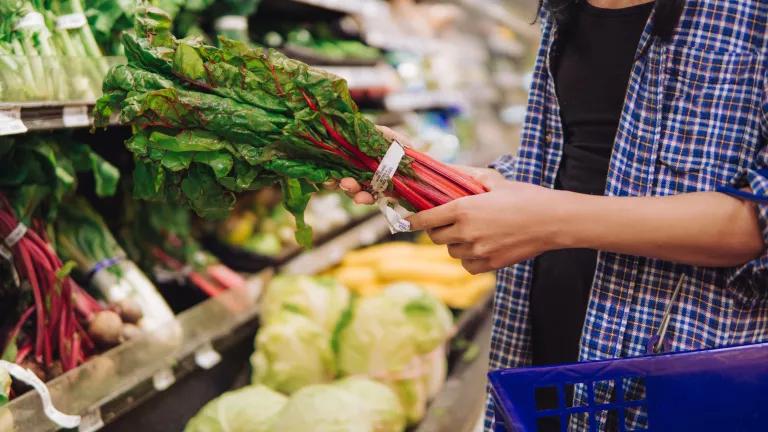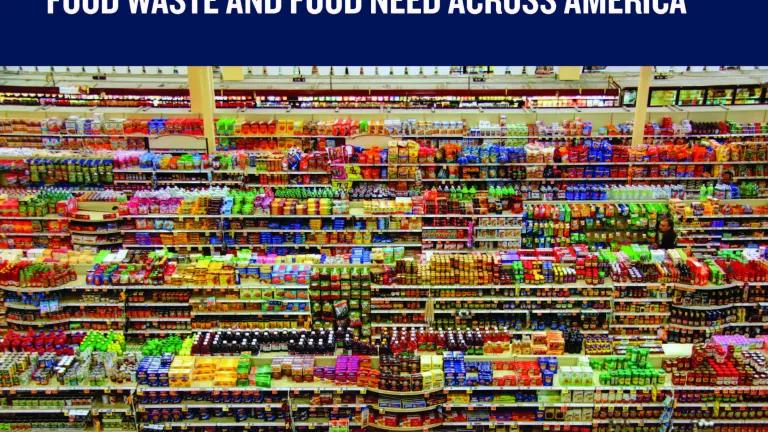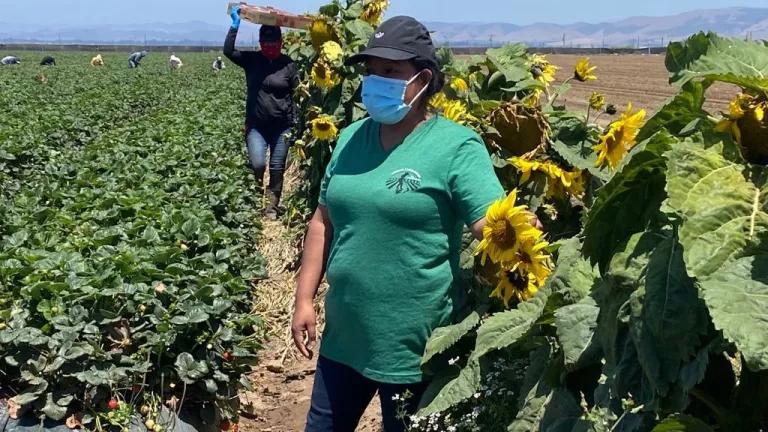Now Is the Time to Improve SNAP for Food Insecure Families

Learn more about NRDC’s response to COVID-19.
As of January 2020, the federal Supplemental Nutrition Assistance Program (SNAP) served more than 37 million people. More than 80 percent of recipient households are families with children, seniors, or those with a disability, and households in poverty receive the vast majority of benefits. With staggering reports of job loss owing to the COVID-19 pandemic, particularly among low-income households, participation in SNAP is expected to grow substantially to meet the program’s goal of alleviating hunger and malnutrition by increasing food security—access by all people at all times to enough food for an active, healthy life.
In a moment of crisis for food insecure families, we must expand and make more flexible this essential safety net to ensure low-income individuals can access fresh, healthy food safely.
Consistent with the lived experiences of environmental justice communities around the country, COVID-19 has laid bare the reality that low-income people of color are disproportionately exposed to risk factors like long-term air pollution and experience worse health outcomes as a result. These same communities have more restricted access to fresh and nutritious foods, inclusive of availability in nearby stores, affordability, and culturally appropriate options. For example, a report from the Environmental Justice Health Alliance for Chemical Policy Reform and Coming Clean that studied nine environmental justice communities found that the most vulnerable neighborhoods—areas that are both low-income and with low access to healthy foods—have higher cancer and respiratory condition risk from nearby facilities emitting toxic air pollution and other sources.
Household food insecurity is also linked to worse health outcomes, especially among already vulnerable populations. For children, not having enough healthy food is associated with delayed development, chronic diseases like asthma and anemia, and behavioral challenges. Among seniors, food insecurity is connected to an increased risk of diabetes, high blood pressure, asthma, and heart attack.
There is a growing body of research linking SNAP with reduced poverty and improved health outcomes. In 2016, SNAP raised the incomes of 7.3 million people above the poverty line, including 3.3 million children. Further, adults who received benefits as young children have lower risk of heart disease and diabetes, while seniors who receive SNAP are less likely to enter a nursing home or be hospitalized.
SNAP is an essential program and can be a critical safety net, especially during a time of record breaking unemployment and lost income. At the same time, inadequacies of the program design, including a failure to consider geographic differences in food prices, the frequency and amount of benefits per household, and strict retailer eligibility standards, are well-documented. Alongside important improvements to SNAP, we must also address disparities in healthy food access by meaningfully increasing local power and wealth in our food system, including to support food service and farm workers who have some of the lowest paying jobs in the country, exacerbating their own food insecurity and reliance on public assistance programs.

To ensure that the goals of the federal program are met, the United States needs to expand SNAP benefits and increase the program’s flexibility in immediate response to the coronavirus pandemic, to bolster families throughout the associated economic downturn, and to make the program more effective long-term for low-income people across the country. To do this Congress and the U.S. Department of Agriculture (USDA) should:
1. Expand and increase SNAP in immediate response to the COVID-19 crisis
Increase SNAP’s maximum allotment by 15% and raise the minimum benefit to $30 per month.
Currently, the estimated average monthly benefit for a family of four is $448. Increasing the maximum allotment by 15 percent would mean an additional $25 per person, per month, and these increases are crucial to meet growing need. In 2018, SNAP benefits averaged only $1.40 per person, per meal. Even the maximum benefit of $1.86 per meal does not cover the cost of a meal in 99 percent of continental counties and Washington, DC.
Further, increasing the minimum SNAP benefit to $30 per month from its current rate of $16 per month would assist the 1.8 million U.S. households currently receiving the minimum benefit, the majority of which are households with seniors.
Extend the Pandemic-Electronic Benefits Transfer (P-EBT) program though the summer and any subsequent months when schools are not in session.
P-EBT is a program that allows families with school-age children to receive benefits to replace the school meals they rely on but may no longer be able to safely access.
A COVID Impact Survey of mothers with children under age 12 found that in nearly one in five of these households, the children themselves are facing food insecurity. This is unprecedented. Even in times of high food insecurity, households are often able to shield children from missing meals or receiving portions with insufficient calories, but with the added burden of widespread school closures where breakfasts and lunches may be available for low-income families, many young children are going hungry. Nineteen states have been approved for P-EBT programs, but the program only operates through the end of the 2019-2020 school year in its current form.
2. Extend all crisis expansions through the end of any COVID-19 recession
In addition to the critical expansions discussed above, programs already in place to provide stronger benefits during the pandemic should continue beyond the immediate public health crisis through any related economic downturn.
Continue to issue “emergency allotments” through the economic downturn.
This emergency program allows states to increase SNAP allotments for those families not currently receiving the maximum benefit for their family size, up to the maximum allotment available. For example, if the maximum benefit for a family of two is $196 per month, but a family is only receiving $100 based on household income, that household would receive $96 more each month.
Currently, USDA can issue waivers to states for this increase in SNAP benefits, but only as long as there is an active federal public health emergency declaration from the Secretary of Health and Human Services and the state has an emergency or disaster declaration in place.
Further suspend the time limit for Able-Bodied Adults Without Dependents through the economic downturn.
Adults between the ages of 18 and 49 without children, referred to in SNAP regulations as Able-Bodied Adults Without Dependents (ABAWD), are subject to a time limit rule and may only receive benefits for three months over a three-year period unless they live in a waived area, qualify for an exemption, or meet work requirements.The current suspension of these time limits runs from April 1, 2020, through the end of the month after the month when the Secretary of Health and Human Services lifts the federal COVID-19 public health emergency declaration.
3. Immediately remove barriers to accessing SNAP benefits
Remove SNAP from any public charge determination.
The “public charge” rule from the U.S. Department of Homeland Security requires immigration officers to determine whether some U.S. visa or green card applicants are likely to become dependent on federal government benefits, including SNAP, in the future. A public charge finding is a reason to deny these applications or admission into the country. Current or prior use of these same benefits can be used as evidence in these immigration determinations, and may serve as a deterrent to SNAP enrollment for families struggling to put food on the table.
Halt any administrative rulemakings that seek to limit SNAP enrollment and benefits.
Any efforts to limit SNAP enrollment and benefits, including actions to make it harder for states to waive their ABAWD requirements, must be halted for the duration of the pandemic and associated economic downturn.
4. Immediately and permanently expand options for using SNAP benefits
Allow SNAP to be used for online grocery shopping in every state and provide the necessary resources for states to establish effective online programs.
In 2019, USDA started a pilot in New York that allows SNAP recipients to use their benefits online at a limited number of stores. Before this pilot, SNAP benefits were required to be used in-person at brick and mortar stores. Currently, USDA has permitted twelve states to launch online SNAP purchasing pilots—giving SNAP users in those states better capacity to safely shop for food.
Increase flexibility for online use in a broader range of retail stores, plus for CSA and farm share programs.
In each of the twelve states approved for online SNAP use, the program is limited to only two, sometimes three, major retail chains, leaving SNAP recipients without meaningful flexibility to safely buy the food they want for their families. Additionally, as institutional, restaurant, and other wholesale markets remain closed, some farmers are interested in shifting their sales to direct-to-consumer channels. Allowing flexibility so that SNAP benefits can be used to buy directly from small and medium-sized farms online can provide critical income for farmers.
The United States must address head on the hunger facing communities as a result of COVID-19. SNAP is one of our most powerful tools to meet the growing need for food security and now is the time to unleash its full potential.





